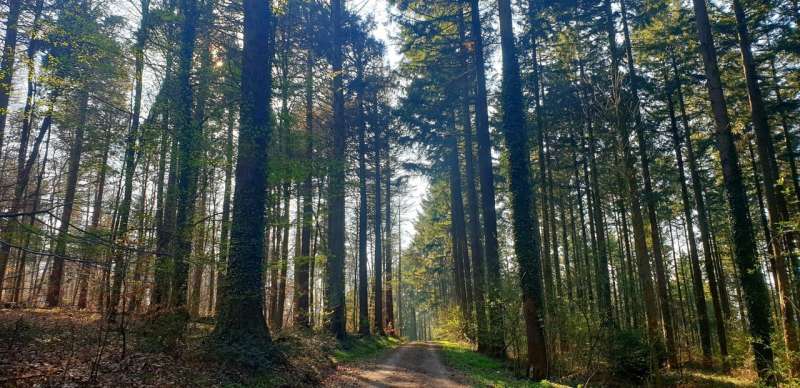This article has been reviewed according to Science X's editorial process and policies. Editors have highlighted the following attributes while ensuring the content's credibility:
fact-checked
peer-reviewed publication
trusted source
proofread
Climate protection: Land use changes cause the carbon sink to decline

Forests can bind large amounts of carbon on the land surface. In this way, they decisively contribute to reducing net greenhouse gas emissions. For some areas, however, data are still lacking. In Eastern Europe, in particular, the network of installed measurement stations is very loose, such that little has been known about carbon flows and their drivers there.
"But Eastern European forests have a great potential as a long-term carbon sink," says Karina Winkler from the Atmospheric Environmental Research Department of the Institute of Meteorology and Climate Research (IMK-IFU), KIT's Campus Alpine in Garmisch-Partenkirchen. "Political upheavals in Eastern Europe, however, have caused big changes of land use. Moreover, climate change there increasingly affects the forests. This unique interaction of socioeconomic and climatic factors influences the carbon sinks."
Study area covers 13 countries
Researchers of IMK-IFU's Land Use Change & Climate Group, together with researchers from other European research institutions, have now recalculated the carbon sinks in Eastern Europe. The area studied covers 13 countries, from Poland in the West to the Russian Ural Mountains in the East, from Estonia in the North to Rumania in the South. Calculations are based on different data sources, such as models, satellite-based biomass estimates, forest inventories, and national statistics. The research is published in the journal Communications Earth & Environment.
"From the datasets, we concluded that Eastern Europe stored most of Europe's carbon from 2010 to 2019," Winkler says. Comparison of carbon balances revealed that the land surface in Eastern Europe bound about 410 million tons of carbon in biomass every year. This corresponds to about 78% of the carbon sink of entire Europe. The biggest carbon sinks can be found in border region of Ukraine, Belarus and Russia, in the southern Ural Mountains, and on the Kola peninsula.
Timber extraction has the biggest influence on the carbon sink in Eastern Europe
However, data also show that carbon absorption in Eastern Europe with time was anything but constant and has even declined. The Eastern European carbon sink is shrinking. To determine the causes, researchers compared the trends of carbon changes with factors of land use, such as land conversion for agriculture, timber extraction, and share of abandoned agricultural areas, as well as with environmental factors, such as temperature, precipitation, soil humidity, and carbon dioxide (CO2) and nitrogen concentrations in the atmosphere.
They found that environmental impacts, such as the change in soil humidity, have a big influence on the carbon balance. Still, spatial patterns of the carbon sink in Eastern Europe can be explained mainly by land use changes. From 2010 to 2019, timber extraction had the biggest influence on the land-based carbon sink in the region. Data analysis suggests that an increase in timber extraction in West Russia and reduced forest growth on former agricultural areas caused the carbon sink in Eastern Europe to decline between 2010 and 2019.
The researchers are now working to predict how Eastern European forests and their important carbon sinks will develop under the influence of land use changes and climate change in future. In view of the increasing number of extreme weather events and reduced water availability, however, they fear that the Eastern European carbon sink will continue to decline.
More information: Karina Winkler et al, Changes in land use and management led to a decline in Eastern Europe's terrestrial carbon sink, Communications Earth & Environment (2023). DOI: 10.1038/s43247-023-00893-4
Journal information: Communications Earth & Environment
Provided by Karlsruhe Institute of Technology




















